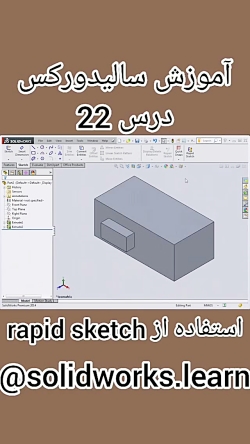

Note the properties of the command in the window to the left, including distance and which side of the original sketch you will be using to create the duplicate entity. To quickly create a dimensionally accurate outer edge, sketch only one edge of the profile, make sure it is selected, and then use the Offset Entities command to duplicate your sketch. Use this opportunity to be creative with the bottom edges and even the angle of the outer wall. The profile is the same as the cross-section of the wall if the mug were to be cut in half.

With the newly created Centerline as your point of reference, select the Line tool again and being sketching the profile of your camping mug’s wall. This Centerline will be used as a point of reference as you move forward with sketching the camping mug profile. To define the other end of the Centerline, drag your mouse back over the red arrow and click approximately just as far below the Front Plane boundary box as you clicked above it, then press Escape to drop the tool. Follow your mouse directly straight up from the up arrow so that there is a blue dotted guideline, then click just above the Front Plane boundary box. Once the Centerline tool is selected, place it in the very center of the Front Plane box over the directional red arrows.

Now that you are looking directly at the Front Plane, head up into the Sketch Toolbar and select Line > Centerline. This ensures that you are looking directly at the front of the Front Plane, which is necessary to sketch with accuracy. In the icons above the working area, select View Orientation > Front. In the Feature Tree to the left of your workspace, select Front Plane. To get started, open up SOLIDWORKS and create a new part. Once completed, the model will provide a perfect example of a product design that can either be rendered to communicate the design plan to others, 3D printed to create a physical prototype or used as a reference to create 2D drawings directly in the software, which can be sent off to a manufacturer for a production quote. We’ll also touch base on some of the most critical SOLIDWORKS building blocks. This model was chosen because of the relative ease with which it can be created. To get you up and running with your first part design, we’re going to be walk through a 10-step process of modeling a lightweight titanium camping mug from scratch. With this tutorial, we will create a simple part that is suitable for manufacturing using the least number of steps.
#WHAT IS RAPID SKETCH IN SOLIDWORKS HOW TO#
I added a few extra entities so that I could use the Selected Contours section of the Extruded Boss/Base command to create my part all from just my one sketch.Understanding how to use design tools efficiently is critical to your career as an engineer. Another great little time saver!Īll that is left is to adjust the dimensions to your liking. Note: Since I used Copy and Paste above, SOLIDWORKS automatically knew to set the circles equal to each other. SOLIDWORKS allows you to use this command with just selected entities as well. I just used All entities in sketch to fully define my sketch by applying combinations of relations and dimensions. Click the Fully Define Sketch button from the Dimensions/Relations toolbar or pull down the Tools menu and pick Dimensions > Fully Define Sketch. You can use the Fully Define Sketch PropertyManager to apply dimensions and relations calculated by SOLIDWORKS to automatically fully define the sketch. Then I used Ctrl+C and Ctrl+V to copy and paste the circles. In the example, I used Window select to select the circles on the left. Use the keyboard shortcuts Ctrl+C and Ctrl+V to copy and paste. A couple of SOLIDWORKS tips that can be very helpful in creating a sketch are: Copy and Paste SOLIDWORKS Sketch Geometry SOLIDWORKS World is always a great place to pick up some useful techniques that many users take for granted. The strongest foundation in creating a good SOLIDWORKS solid model is a sketch. There are many ways to build a SOLIDWORKS part document.


 0 kommentar(er)
0 kommentar(er)
